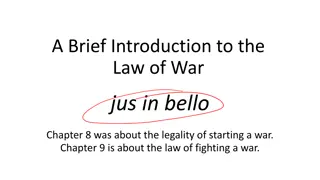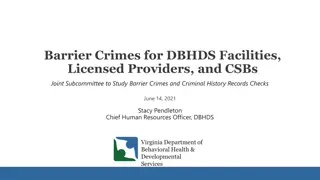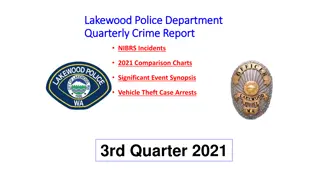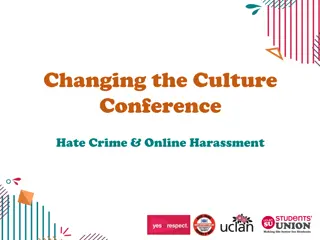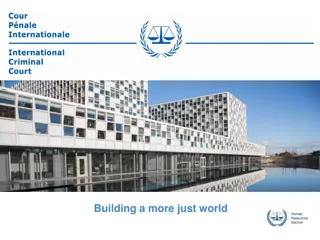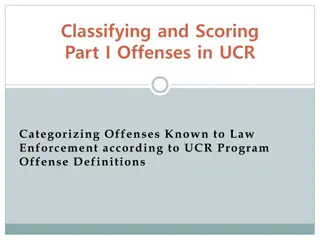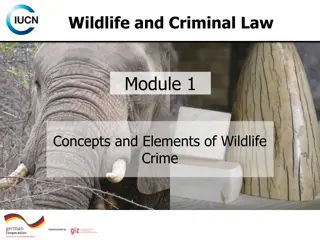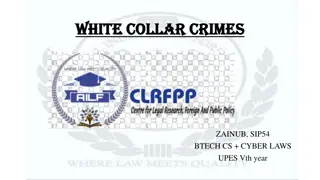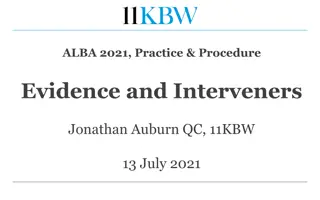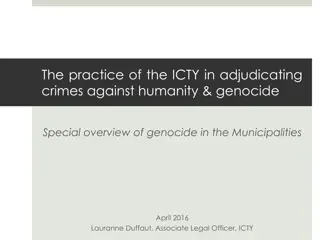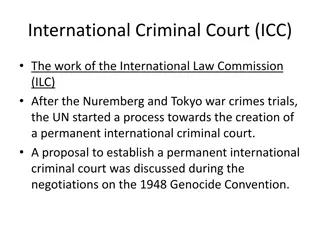International Crimes: Elements, Definitions, and Evidence
International crimes encompass acts like crimes against humanity, war crimes, and genocide, with various legal elements to establish accountability. To substantiate such crimes, individuals must prove contextual, linkage, and specific elements. Evidence of sexual violence is crucial in proving these crimes and can be relevant to multiple offenses. Understanding the legal elements is key to gathering pertinent evidence.
Download Presentation

Please find below an Image/Link to download the presentation.
The content on the website is provided AS IS for your information and personal use only. It may not be sold, licensed, or shared on other websites without obtaining consent from the author.If you encounter any issues during the download, it is possible that the publisher has removed the file from their server.
You are allowed to download the files provided on this website for personal or commercial use, subject to the condition that they are used lawfully. All files are the property of their respective owners.
The content on the website is provided AS IS for your information and personal use only. It may not be sold, licensed, or shared on other websites without obtaining consent from the author.
E N D
Presentation Transcript
Module 2 Sexual Violence as an International Crime INTERNATIONAL PROTOCOL PART 1 MODULE 2, PAGES 16-26 EVIDENCE WORKBOOK, ANNEX 1
What is an international crime? Most acts of violence will be a crime under national law murder, rape, assault, theft etc. Under certain circumstances, the same act can also constitute an international crime a violation of international criminal law International law usually only applies to states, but international criminal law, including parts of international humanitarian law (law of armed conflict), can also make individuals legally accountable for their actions There are three main types of international crime: CRIMES AGAINST HUMANITY WAR CRIMES GENOCIDE
What makes something an international crime? International Protocol, pages 16-18 There are many sources of international criminal law, such as: Treaties (e.g. Rome Statute) Customary law Jurisprudence The definitions of international crimes can vary between different jurisdictions you must find out which laws apply in your context Generally, to hold individuals accountable for an international crime, you will need to prove three separate categories of legal elements: CONTEXTUAL ELEMENTS (under what circumstances?) LINKAGE ELEMENTS (who is responsible and HOW?) SPECIFIC ELEMENTS (what happened?)
A) Specific elements of crimes International Protocol, pages 18-23 Evidence Workbook, Annex 1 Module 6 Testimony and Module 7 Interviewing Module 8 Additional Sources of Information EVIDENCE OF SEXUAL VIOLENCE IS ALWAYS RELEVANT It can be used to prove both specific sexual violence crimes and other international crimes that can be committed by using sexual violence The victim or witness is likely to have evidence about both crimes of sexual violence and other crimes the same facts can be relevant to more than one specific crime If you understand the legal elements of the crime that must be proven, you can collect more relevant evidence
A) Specific elements of crimes war crimes International Protocol, pages 19-20 Evidence Workbook, Annex 1 Specific crimes of sexual violence Other relevant war crimes Rape Torture Sexual slavery Cruel treatment Forced pregnancy Mutilation Enforced prostitution Use of child soldiers Enforced sterilisation Outrages on personal dignity Other forms of sexual violence Humiliating or degrading treatment
A) Specific elements of crimes crimes against humanity International Protocol, pages 20-21 Evidence Workbook, Annex 1 Specific crimes of sexual violence Other relevant crimes against humanity Rape Murder Sexual slavery Torture Forced pregnancy Persecution Enforced prostitution Imprisonment Enforced sterilisation Extermination Other forms of sexual violence Other inhumane acts
A) Specific elements of crimes genocide International Protocol, page 21 Evidence Workbook, Annex 1 Specific acts of genocide Killing members of the group Causing serious bodily or mental harm to members of the group Bringing about conditions of life calculated to destroy the group Imposing measures intended to prevent births within the group Forcibly transferring children of the group to another group
A) Specific elements of crimes International Protocol, pages 18-23 Evidence Workbook, Annex 1 Module 6 Testimony and Module 7 Interviewing Module 8 Additional Sources of Information Torture is a war crime and a crime against humanity, but national criminal codes often address it as a separate crime The crime of rape can be committed against a man or a woman under international law in some jurisdictions, it can only be committed by a man against a woman The crime of other forms of sexual violence can include forcing someone to commit sexual violence Make sure that you understand the law relevant to your work, including any relevant law on procedure and evidence
B) Contextual elements of crimes International Protocol, pages 23-25 Evidence Workbook, Annex 1 Module 1 Understanding Sexual Violence Module 6 Testimony and Module 7 Interviewing Module 8 Additional Sources of Information The background circumstances of an act must reach a threshold of seriousness that raises them to the level of international crimes For each of the three categories of international crimes war crimes, crimes against humanity and genocide there are certain contextual elements that must be proven This means that you must establish certain facts about the circumstances under which the act took place for it to qualify as an international crime
B) Contextual elements of crimes sexual violence as a war crime International Protocol, pages 23-24 Evidence Workbook, Annex 1 You must show that the act took place and was associated with in the context of AN ARMED CONFLICT (international or non-international) and that the direct perpetrator was aware of the existence of the armed conflict
B) Contextual elements of crimes sexual violence as a war crime International Protocol, pages 23-24 Evidence Workbook, Annex 1 Sexual violence is a war crime in both international and non- international armed conflicts (different legal frameworks can have multiple and/or different definitions for each of these types of armed conflict) Unlike other war crimes, it is not necessary to prove that a victim of sexual violence was a civilian or other protected person As long as the other contextual elements for war crimes have been met, sexual violence will always constitute a war crime regardless of the status of the victim War crimes and crimes against humanity often overlap the same act can sometimes satisfy the legal elements for both
B) Contextual elements of crimes sexual violence as a crime against humanity International Protocol, pages 23-24 Evidence Workbook, Annex 1 You must show that the act was part of a widespread systematic OR ATTACK AGAINST A CIVILIAN POPULATION knew intended and that the direct perpetrator or part of the attack that their conduct would form
B) Contextual elements of crimes sexual violence as a crime against humanity International Protocol, pages 23-24 Evidence Workbook, Annex 1 Crimes against humanity can take place during war or in peacetime, as long as the act in question was committed as part of an attack against the civilian population The attack does not have to be armed/military, but it must be widespread or systematic some jurisdictions also require evidence of a state or organisational policy to commit the attack You do not have to show that sexual violence was widespread or systematic, only that it was committed as part of the attack Evidence of large-scale sexual violence can also help prove the attack
B) Contextual elements of crimes sexual violence as genocide International Protocol, pages 24-25 Evidence Workbook, Annex 1 You must show that the act was committed with the intent to destroy in whole or in part A NATIONAL, ETHNIC, RACIAL OR RELIGIOUS GROUP as such
B) Contextual elements of crimes sexual violence as genocide International Protocol, pages 24-25 Evidence Workbook, Annex 1 Module 1 Understanding Sexual Violence Genocide does not necessarily or just mean mass killing sexual violence can constitute several underlying acts of genocide, particularly causing serious bodily or mental harm Genocide is not an easy crime to prove it is often difficult to find evidence of the specific intent to destroy the group Only national, ethnic, racial or religious groups are covered by the crime of genocide under international law, but targeting members of other groups on discriminatory grounds such as gender or political opinion -- could still constitute the crime against humanity of persecution
C) Linkage elements of crimes International Protocol, pages 25-26 Evidence Workbook, Annex 1 Module 3 Preliminary Considerations Module 5 Identifying Survivors and Other Witnesses Module 6 Testimony and Module 7 Interviewing Module 8 Additional Sources of Information The mode of liability is a legal term which refers to different forms of personal responsibility for a crime Under international law, it is possible to hold to account not just the direct perpetrator of sexual violence, but also those who allow, encourage or remotely influence its commission Whatever forms of criminal liability apply in your jurisdiction, it is still crucial for you to document detailed information that could help prove a link to those responsible for the crime
C) Linkage elements of crimes International Protocol, pages 25-26 Evidence Workbook, Annex 1 These are the main modes of liability used by the International Criminal Court. There may be others which apply in your jurisdiction. You must show that the suspect formed a common plan with a group of people to commit international crimes Co-perpetration/ common purpose You must show that the suspect exercised control over the crime/direct perpetrator and intended to commit the crime Indirect perpetration You must show that the suspect had the authority to issue orders and expected them to be carried out Ordering
C) Linkage elements of crimes International Protocol, pages 25-26 Evidence Workbook, Annex 1 These are the main modes of liability used by the International Criminal Court. There may be others which apply in your jurisdiction. You must show that the suspect encouraged, provoked, incentivised or convinced the direct perpetrator to commit sexual violence Soliciting/ inducing You must show that the suspect provided practical assistance, moral support to the direct perpetrator Aiding and abetting encouragement or You must show that the civilian or military authority had effective control, knew or should have known violence and failed to prevent or punish it Superior/ command responsibility about the sexual
Recognising the elements of international crimes Evidence Workbook pages 80-81, 83-84, 92-93 and 98 EXERCISE Carefully read and discuss the scenarios on pages 80-81, 83-84, 92-93 and 98 of the Evidence Workbook What international crimes do you think might be relevant to those facts?
Recognising the elements of international crimes Evidence Workbook pages 80-81, 83-84, 92-93 and 98 EXERCISE In groups, discuss whether the information contained in that testimony would satisfy the necessary elements for each of the three required categories: specific, contextual and linkage evidence If some information is missing or you realise there are some gaps in your evidence, discuss how you would go about finding the missing information use the other examples in the Evidence Workbook as a guide
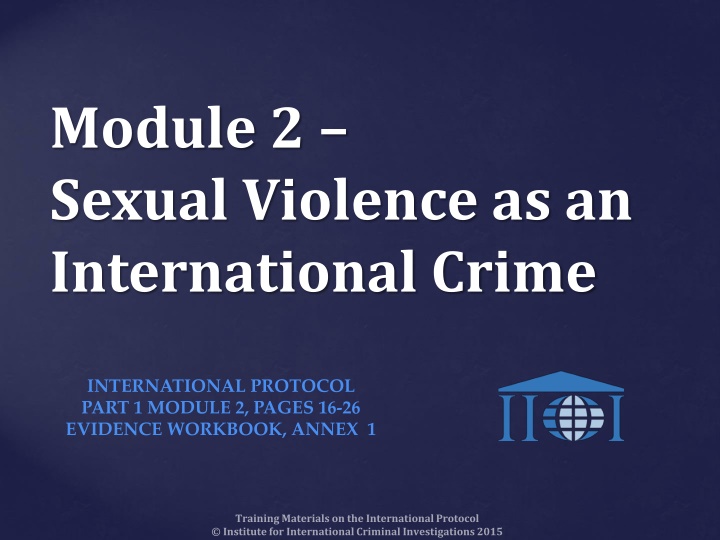

![Prevention and Combating of Hate Crimes and Hate Speech Bill [B.9B.2018]](/thumb/60513/prevention-and-combating-of-hate-crimes-and-hate-speech-bill-b-9b-2018.jpg)



